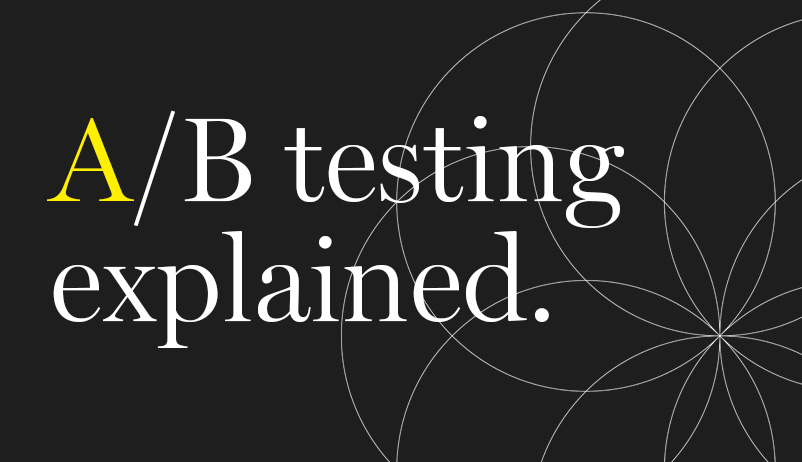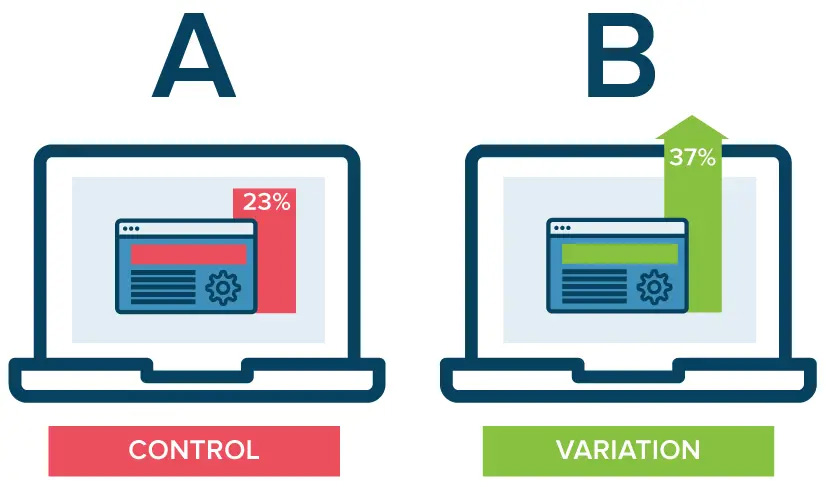

AB Testing
AB Testing
What is A/B Testing?
Lorem ipsum dolor sit amet, consectetur adipiscing elit. Suspendisse varius enim in eros elementum tristique. Duis cursus, mi quis viverra ornare, eros dolor interdum nulla, ut commodo diam libero vitae erat. Aenean faucibus nibh et justo cursus id rutrum lorem imperdiet. Nunc ut sem vitae risus tristique posuere.
Introduction — Why A/B Testing Matters
In an environment where customer expectations evolve rapidly and digital competition accelerates continuously, businesses can no longer rely on intuition alone to optimise performance. A/B testing — the practice of comparing two or more versions of a webpage, message, or experience to determine which performs better — has become a core mechanism for reducing uncertainty and improving commercial outcomes through evidence-based decision-making.
A/B testing has its roots in experimental statistics, yet its relevance today spans industries and organisational maturity. Whether a business is refining an e-commerce checkout journey, evaluating messaging on a landing page, or testing new pricing displays within a SaaS product, experimentation enables leaders to validate ideas in controlled conditions before allocating broader resource. The result is faster learning cycles, more efficient marketing investment, and a greater likelihood that changes deliver measurable uplift rather than cosmetic enhancement.
Importantly, A/B testing has structural value beyond incremental performance gains. It institutionalises a learning mindset: decisions are formed through hypothesis, measurement and iteration rather than opinion or hierarchy. This reduces organisational bias, supports commercial alignment, and provides clarity on which interventions genuinely influence customer behaviour. For early-stage organisations, A/B testing helps accelerate product–market fit; for mature companies, it enables continuous optimisation as customer needs and channel dynamics evolve.
The discipline is widely used across digital marketing, UX design, product development, and conversion rate optimisation. As data accessibility increases and experimentation tools become more sophisticated, A/B testing plays a pivotal role in helping organisations compete more effectively — balancing creativity with analytical rigour to drive sustainable growth.

"A/B Testing allows you to compare, measure, and optimise with confidence. This powerful method reveals what works best for your audience, saves time and money, but demands traffic and diligent implementation for meaningful results."
Paul Mills - Chartered Fractional CMO & Founder, VCMO
What Is A/B Testing?
A/B testing is a controlled experimentation method used to compare two or more variations of a webpage, message, design element, feature or process to determine which version performs better against a defined goal. At its simplest, it involves randomly dividing an audience into groups — typically a control group (A) and one or more treatment groups (B, or B/C/etc.) — then measuring differences in user behaviour. The objective is to understand how specific changes influence outcomes such as engagement, conversions or revenue, allowing organisations to make evidence-based improvements.
Originally rooted in statistical hypothesis testing, A/B testing has evolved into a central pillar of digital optimisation. Modern platforms allow businesses to test small changes — such as wording on a call-to-action — or more complex variations including pricing models, onboarding flows or checkout experiences. Regardless of scope, the methodology remains consistent: isolate a variable, define a hypothesis, run the test with adequate sample size, and evaluate results objectively.
A/B testing differs from more exploratory research methods in that it provides causal evidence. Rather than inferring intent from surveys or interviews, it demonstrates how real users behave when exposed to controlled variation. This makes it especially valuable in digital environments where subtle decisions — such as button placement or messaging emphasis — can materially affect performance at scale.
Today, A/B testing is widely used across marketing, product management, UX design, and commercial strategy. For high-growth digital businesses, it forms part of a broader experimentation discipline aimed at improving customer experience, reducing friction and systematically increasing commercial efficiency. By separating assumptions from validated learning, A/B testing helps organisations improve performance confidently and sustainably.

Why You Should A/B Test
A/B testing is essential because it allows organisations to base optimisation decisions on evidence rather than intuition. In markets where customer journeys span multiple channels and micro-interactions influence conversion behaviour, even small improvements can compound into meaningful commercial gains. By comparing controlled variations, leaders can identify which changes genuinely enhance performance, reducing the risk of misguided investment and enabling more efficient allocation of marketing and product resources.
A key benefit of A/B testing is its ability to reduce uncertainty. Many organisations introduce new messaging, features or experience adjustments without validating their assumptions. As a result, well-intended changes sometimes harm engagement or conversion. A/B testing mitigates this by allowing organisations to trial updates on a subset of users, validate outcomes, and only roll out enhancements once there is evidence of uplift. This disciplined approach promotes incremental progress while limiting downside risk.
The method also supports a culture of continuous improvement. Rather than treating optimisation as a periodic exercise, A/B testing encourages ongoing experimentation across digital touchpoints. Teams learn continuously, uncovering insights about user preferences, motivators and friction points. These insights help refine broader marketing and product strategy, strengthening competitive advantage over time.
Commercially, A/B testing can deliver measurable benefits — increased conversion rates, reduced customer acquisition cost, improved retention and greater customer lifetime value. In environments such as e-commerce or SaaS, where changes can be deployed rapidly and measured in real time, experimentation becomes a core mechanism for scaling efficiently and profitably.
Ultimately, A/B testing helps businesses make smarter decisions. It aligns creativity with data, reduces reliance on subjective judgement, and ensures that customer behaviour — not opinion — drives optimisation. In doing so, it increases confidence in strategic direction and enables organisations to pursue growth systematically and sustainably.
Key Concepts
A/B testing is grounded in statistical experimentation. To apply it effectively, business leaders must understand several core concepts that shape experimental design, interpretation and decision-making.
1) Control and Variant
Every A/B test compares a baseline version — the control (A) — with one or more variants (B, C, etc.). The control represents current performance; the variant contains a single intentional change. By measuring how audiences behave across both versions, organisations identify whether the modification drives improvement.
2) Hypothesis Formation
Effective A/B testing begins with a clear hypothesis. This defines the expected outcome and the rationale behind the change.
For example:
“If we simplify the sign-up form by removing non-essential fields, more users will complete registration.”
Hypothesis clarity ensures that testing is purposeful rather than exploratory.
3) Statistical Significance
Statistical significance determines whether observed differences in performance are likely caused by the changes made, rather than chance. When performance varies between control and variant, organisations must confirm that the difference is statistically valid before acting on it. Significance thresholds (often p < 0.05) help quantify confidence in results.
4) Confidence Level and p-Value
The confidence level (e.g., 95%) represents the probability that the observed outcome reflects a true effect. The p-value reflects the likelihood that results occurred randomly. Together, they guide decision-makers on whether to adopt or reject the variant.
These concepts underpin disciplined experimentation. Understanding them ensures that A/B testing activity is grounded in rigorous methodology rather than guesswork, enabling more reliable insights and more confident commercial decisions.
Types of A/B Tests
A/B testing can be implemented in several formats depending on the complexity of the variation being assessed, the volume of traffic available, and the breadth of hypotheses under consideration. Selecting the right test type ensures statistical reliability and helps organisations balance learning speed with execution effort. Below are the principal formats most commonly used in marketing, product optimisation and UX experimentation.
- Simple A/B Test - A simple A/B test compares a single control variant (A) with one alternative variant (B). It is the most common form of experimentation, used to assess the impact of an isolated change such as a different headline, CTA, or image. This format is best suited to environments with modest traffic or when learning goals are narrowly defined.
- A/B/n Test - An A/B/n test expands beyond a single variation, testing multiple variants against a control simultaneously — for example, comparing three different CTA messages. This accelerates insight generation but requires a larger sample size to achieve statistical significance. A/B/n tests are useful when teams wish to explore multiple creative or structural directions within one experiment.
- Multivariate Test (MVT) - Multivariate testing evaluates the effect of multiple element changes at once — such as combining different headlines, layouts and images. The objective is not only to identify which combination performs best but also to measure the interaction effect between variables. MVT requires substantial traffic and advanced tooling but can produce deep insight into design efficiency and messaging interplay.
- Multipage Test (or Funnel A/B Test) - Multipage tests assess changes applied across several consecutive steps in a user journey — for example, modifying a checkout flow or onboarding sequence. Rather than testing a single page in isolation, these experiments evaluate cumulative performance across the funnel. This approach is valuable when organisations want to understand how end-to-end experience changes influence conversion at scale.
Together, these testing styles form a flexible toolkit. By matching test type to traffic volume, organisational maturity and learning objectives, businesses can optimise experimentation efficiency and extract more meaningful commercial insight.
What Should You Test?
Almost any digital touchpoint can be optimised through A/B testing, but not all variables are equally valuable. The highest-impact tests focus on elements that shape customer understanding, minimise friction and influence decision-making. Grouping test variables into strategic categories helps teams prioritise where experimentation is most likely to deliver measurable commercial uplift. Common elements tested include (but not limited to):
- Messaging & Value Communication - Language strongly affects how users interpret value. Testing headlines, sub-headings, calls-to-action (CTAs), benefit statements, product descriptions and email subject lines can reveal which messages resonate best. Small changes — such as shifting from feature-led to outcome-led language — can materially influence conversion, particularly in competitive or high-consideration categories.
- Visual Design & UI Elements - Design cues shape attention, clarity and emotional response. Testing images, colour palettes, button styles, spacing, iconography and typography can improve comprehension and reduce cognitive load. These adjustments often yield rapid conversion improvements because they affect how quickly users can understand what action to take and why.
- User Experience & Flow - Flow-based optimisation reduces friction. Experimentation might include form length, field ordering, validation logic, navigation structure, progressive disclosure, or use of microcopy. These tests are particularly valuable on sign-up, checkout and onboarding flows where abandonment is high and friction is costly.
- Page Layout & Information Hierarchy - Re-ordering components — such as moving testimonials higher, altering scannability or refining the hero layout — influences perceived relevance and trust. Iterating layouts helps teams understand how users prioritise information and which elements drive action.
- Offers, Pricing & Incentives - Price framing, promotional formats, guarantees, payment options and trial offers can all be tested to determine their effect on adoption. These experiments often deliver strong commercial impact because they shape value perception directly.
How to Run an A/B Test (Step-by-Step)
A/B testing is most effective when executed through a structured, repeatable process. Following a disciplined workflow ensures that experiments are grounded in clear hypotheses, run with appropriate controls, and interpreted with statistical confidence. The steps below outline a practical approach that organisations of all sizes can apply to improve decision-making and achieve measurable commercial impact.
Step 1) Define the Goal
Every test should address a specific business objective, such as increasing form completions, improving click-through rate or reducing checkout abandonment. Clear goals create focus and shape downstream design decisions.
Step 2) Form a Hypothesis
Develop a prediction that explains why the change might improve performance.
Example: “Reducing the number of required fields will increase sign-ups because users face less friction.”
A well-formed hypothesis anchors the test and prevents random experimentation.
Step 3) Identify the Variable
Select the single element to change — such as a headline, button colour or form length. Isolating variables helps ensure that any uplift or decline can be attributed to the change being tested.
Step 4) Create the Variant(s)
Build one or more alternative versions that reflect the hypothesis. These should differ only in the chosen variable to preserve clarity of interpretation.
Step 5) Split the Audience
Randomly divide traffic between the control and variant(s). Traffic should be distributed evenly unless there is a strategic reason to weight exposure.
Step 6) Determine the Test Duration
Run the experiment long enough to reach statistical validity. Duration depends on traffic volume, conversion rate and required confidence level; stopping too early increases the risk of false conclusions.
Step 7) Analyse Results
Evaluate performance against the goal. Assess statistical significance, confidence levels and practical impact — not just numerical difference. Consider secondary metrics to understand any unintended effects.
Step 8) Act on Findings
If the variant significantly outperforms the control, roll it out more broadly. If not, revert and assess learnings. Results should feed into future hypotheses.
Step 9) Iterate
A/B testing is cumulative. Organisations should document learnings, refine hypotheses, and continue experimentation to drive sustained optimisation.
Common A/B Testing Examples
A/B testing can be applied across a wide spectrum of marketing, product and experience environments. Its value lies in isolating the changes that most meaningfully influence behaviour. The following examples illustrate how experimentation can uncover actionable insight and drive measurable performance uplift.
Example 1 - Landing Page Conversion — CTA Wording
A SaaS business offering free product trials notices that a significant proportion of site visitors exit without converting. To improve performance, the team tests two call-to-action variants:
- A) “Start Free Trial” (control)
- B) “Try It Free — No Credit Card Needed” (variant)
The variant delivers a higher click-through rate and trial activation because it reduces perceived risk. The test demonstrates how subtle messaging changes can materially influence early-stage acquisition without altering product functionality.
Example 2 - Checkout Flow Optimisation — Form Simplification
An online retailer identifies a high abandonment rate during checkout. The team hypothesises that reducing friction will improve completion. They test removing optional fields and shortening the form from three steps to two.
The simplified variant increases conversion-to-purchase, shortens completion time and reduces mobile drop-off. This example shows how UX adjustments can directly influence revenue by reducing effort at a critical stage in the funnel.
Example 3 - Email Campaign Engagement — Subject Line Personalisation
A financial services provider wants to increase engagement with its monthly newsletter. They test two subject line formats:
- A) “Your September Market Update”
- B) “Paul — Your September Market Update”
The personalised version increases open rate and downstream click-through. While modest in scope, this test demonstrates how personalisation can enhance relevance and strengthen engagement — particularly within established contact databases.

A/B Testing Metrics
Selecting the right metrics is critical to interpreting A/B test outcomes effectively. While conversion rate improvement is often the primary focus, meaningful optimisation requires a broader measurement framework to understand both direct and secondary effects. Well-defined metrics help determine whether the variant supports strategic objectives, improves user behaviour and delivers commercially relevant performance gains.
- Primary Metrics - Primary metrics measure the specific outcome a test is designed to influence. These may include click-through rate (CTR), sign-up rate, form completion, purchase conversion or revenue per visitor. Because they map directly to the test hypothesis, primary metrics should be singular, clearly defined and stable across the duration of the experiment. Over-expanding the primary metric set makes interpretation more difficult and increases noise.
- Secondary Metrics - Secondary metrics provide context. For example, a variant may improve conversion but reduce average order value or increase refund rates. Monitoring secondary metrics — such as bounce rate, time on page, exit rate, scroll depth and customer support contact — helps identify unintended effects that could undermine long-term performance. Understanding these knock-on impacts prevents premature scaling of variants that introduce hidden risks.
- Commercial Metrics - Many tests ultimately seek commercial uplift. In these cases, monetised measures such as average order value (AOV), customer acquisition cost (CAC), customer lifetime value (CLV), gross margin or renewal rate provide essential insight. These metrics reveal whether apparent performance gains translate into meaningful commercial value. Organisations should avoid optimising exclusively for surface-level metrics when deeper indicators tell a different story.
- Sample Size & Test Power - A/B tests must reach adequate sample size to produce statistically valid results. Calculating minimum detectable effect, expected conversion rate and required confidence level ensures sufficient power to avoid false positives or false negatives. Underpowered tests risk misinterpretation, leading to ill-informed decisions.
Understanding A/B Test Results
Interpreting A/B test results requires more than simply identifying which version delivered a higher conversion rate. Effective evaluation examines statistical validity, practical significance and broader contextual impact to ensure decisions reflect genuine behavioural change rather than random variation. Misinterpretation can lead teams to implement ineffective variants or overlook promising improvements, limiting the strategic value of experimentation.
- Statistical Significance - Statistical significance indicates whether observed differences between the control and variant(s) are unlikely to have occurred by chance. A commonly used threshold is p < 0.05, suggesting a less than 5% probability that the result is random. Statistical significance confirms the reliability of an observed effect — but does not by itself prove that the change is commercially meaningful.
- Practical (Commercial) Significance - Even where results are statistically significant, the actual impact may be too small to justify implementation. For instance, a 0.2% uplift may not warrant rollout if the operational cost outweighs the benefit. Assessing practical significance ensures teams implement variants that deliver material value rather than purely mathematical improvement.
- Confidence Intervals - Confidence intervals describe the range within which the true effect is likely to fall. Narrower intervals indicate higher certainty, whereas wider ranges suggest greater variance and potential instability. Confidence intervals help organisations understand the potential upside and downside of a variant rather than relying on a single point estimate.
- Secondary Effects & Behavioural Insight - Beyond headline results, organisations must assess secondary impacts — such as changes in average order value, retention, satisfaction or downstream engagement. These metrics provide a more complete view of performance and help identify whether improvements in a single step create downstream friction.
Understanding results holistically ensures that decisions reflect the full customer journey and broader commercial dynamics.
Which Statistical Approach to Use? (Frequentist vs Bayesian)
A/B testing relies on statistical methods to determine whether observed differences between variants are meaningful. Two dominant approaches underpin most experimentation platforms: Frequentist and Bayesian statistics. Both can support robust decision-making, but they differ in how results are calculated, interpreted and communicated. Understanding these differences helps organisations select the most appropriate method based on traffic levels, decision speed, and risk tolerance.
The table below summarises key distinctions:
In practice, both methods can be valid. Frequentist models suit organisations requiring clear thresholds and fixed test cycles, while Bayesian approaches offer flexibility and more intuitive insight — advantageous in agile or lower-traffic environments. Many experimentation platforms now support both, allowing organisations to choose based on business context rather than statistical ideology.
Segmenting A/B Tests
Segmentation enhances the value of A/B testing by revealing how different customer groups respond to the same change. While headline conversion rates indicate overall performance, user behaviour is rarely uniform. Preferences, motivations and constraints vary by demographic, geography, device, acquisition channel and prior engagement. Analysing test results at the segment level helps organisations understand why a variant succeeds or fails — and for whom — enabling more precise optimisation and targeted rollout.
Why Segmentation Matters
Segmentation prevents misleading conclusions. A variant may show neutral or modest improvement at an aggregate level but outperform materially within a high-value sub-group. Likewise, a change that appears beneficial overall may negatively affect key segments, leading to revenue dilution if rolled out universally. Segmentation also helps uncover context-specific insights that guide future testing hypotheses and channel-level strategy.
Types of Segmentation
Segmentation can be based on several dimensions:
- Demographic: age, location, language
- Behavioural: returning vs new users, on-site actions
- Acquisition source: organic search, paid, social, email
- Device type: desktop vs mobile
- Customer value: high-value accounts, subscribers, purchasers
These lenses provide nuance that aggregate data obscures, improving understanding of how different audiences behave.
When to Segment
Segmentation should be applied once the test has reached statistical validity overall. Over-segmentation too early increases the risk of random noise and false signals. Prioritising high-impact segments — such as core personas, strategic markets or high-value customers — ensures insight remains actionable.
Segmentation strengthens the strategic value of experimentation. By revealing differential impact across groups, it allows organisations to tailor experiences more effectively, allocate resources to high-yield cohorts and scale only where performance is proven.
A/B Testing & SEO
A/B testing can be highly beneficial for improving user experience and conversion performance, but it must be executed carefully to avoid harming search engine visibility. Search engines are increasingly sophisticated in evaluating dynamic site experiences; however, poorly implemented tests can inadvertently create issues such as duplicate content, cloaking risk or indexation problems. Ensuring SEO integrity requires thoughtful design, technical safeguards and disciplined monitoring.
At its core, A/B testing poses no inherent conflict with SEO. Google and other search engines acknowledge that experimentation is a legitimate and valuable optimisation practice. Common test elements — such as changing headlines, altering imagery or re-ordering page modules — are generally safe when implemented correctly. Problems arise when test variants serve different content to users and crawlers, or when URLs proliferate without proper canonicalisation, leading to potential ranking instability.
One best practice is to ensure consistent content delivery to both search bots and users. Serving different versions to crawlers than to visitors may be interpreted as cloaking — a violation of search guidelines. Instead, organisations should use client-side testing or server-side rendering that treats all traffic consistently. Where multiple URLs exist, canonical tags can help consolidate indexing signals and prevent fragmentation.
Equally important is test duration. Running experiments for extended periods can confuse search engines, particularly if variants differ materially in structure or messaging. Limiting test length and implementing permanent changes only after validation helps maintain ranking stability. Redirect-based tests should use 302 (temporary) redirects, signalling that the test is not a permanent change.
Finally, testing should be evaluated not only on conversion uplift but also on organic performance. Monitoring metrics such as rankings, impressions and organic click-through rates helps identify unintended SEO consequences. When implemented thoughtfully, A/B testing and SEO coexist productively — supporting stronger user engagement while safeguarding search visibility.
Fractional Futures Podcast - Listen to Where SEO Is Heading in 2025 & Beyond
In this episode of Fractional Futures, host Paul Mills is joined by Ryan Jones (Marketing Manager, SEO Testing) and discuss the evolving landscape of SEO in the context of AI advancements. They explore how AI is reshaping search strategies, the importance of digital PR, and the need for marketers to adapt to a multi-channel approach. Episode length 24 minutes.
A/B Testing & GEO (Generative Engine Optimisation)
As generative AI platforms such as ChatGPT, Perplexity, Gemini and Claude increasingly influence how users discover and evaluate brands, Generative Engine Optimisation (GEO) has become an emerging strategic discipline. GEO focuses on improving how content is interpreted, summarised and recommended by AI engines — a shift beyond traditional keyword-based search optimisation. Within this landscape, A/B testing provides a structured mechanism for testing how content variations affect model interpretation and prominence within AI-driven responses.
Unlike traditional SEO, which prioritises ranking performance in search engines, GEO considers how generative systems ingest, contextualise and reproduce information. Experiments might include testing alternative metadata structures, information hierarchies, narrative framing, entity-rich phrasing or the positioning of authority signals such as credentials and trusted sources. The aim is to understand which versions are more likely to be surfaced when users ask AI models informational or transactional queries.
A/B testing for GEO remains nascent because many generative engines are not yet fully transparent about ranking signals. However, businesses can experiment with content variants across owned properties and monitor downstream impact through referral analytics, share-of-voice tracking in AI summaries, and third-party GEO monitoring tools. Testing can help evaluate whether clearer structuring, higher factual density, improved schema markup or enhanced topical depth increases citation frequency within AI results.
A key challenge is attribution: AI systems may reframe content non-linearly, making outcome measurement less straightforward than in conventional SEO. Thus, organisations must evaluate GEO-driven tests over longer time horizons and combine qualitative observation with quantitative data.
While still an emerging practice, A/B testing offers a disciplined way to explore how content quality, clarity and authority influence generative engine outcomes — positioning organisations to stay visible as user discovery behaviour continues to evolve.
Creating a Culture of A/B Testing
Sustained experimentation is most effective when supported by organisational culture rather than executed as an isolated tactic. A/B testing works best in environments where curiosity is encouraged, assumptions are challenged, and decisions are grounded in evidence rather than seniority or instinct. Building this culture requires aligned leadership, clear processes and the right blend of skills, tooling and governance to ensure experimentation delivers commercial value.
- Leadership and Mindset - Cultural adoption begins with leadership commitment. Senior stakeholders must reinforce that hypotheses, testing and iteration are trusted decision pathways. This shifts organisational behaviour away from instinct-led decision-making toward data-driven learning. Leaders model the expectation that not every test will “win” — what matters is extracting insight that informs the next improvement cycle.
- Cross-Functional Collaboration - A/B testing sits at the intersection of marketing, product, engineering and analytics. Collaboration ensures hypotheses are grounded in customer insight, variants can be implemented efficiently and results are interpreted rigorously. Successful organisations create shared rituals — such as fortnightly test reviews — where teams discuss learnings, prioritise new ideas and maintain momentum.
- Documentation and Transparency - Maintaining a clear record of experiments — including hypotheses, variants, metrics, results and decisions — accelerates institutional learning. Documentation prevents repeated mistakes, highlights proven patterns and enables new team members to onboard quickly. Transparency also encourages constructive challenge and strengthens analytical discipline.
- Tooling, Skills and Enablement - Modern experimentation platforms make A/B testing accessible, but capability development remains essential. Teams require skills in hypothesis formation, statistical literacy, UX design and data interpretation. Training and shared resources help normalise best practice and ensure experiments are run with sufficient rigour to support confident decision-making.

Common Mistakes to Avoid
While A/B testing is conceptually straightforward, execution pitfalls are common. These errors compromise data quality, generate misleading conclusions and can lead to poor commercial decisions. Recognising and avoiding these mistakes helps organisations extract maximum value from experimentation and maintain confidence in test-driven optimisation.
1) Testing Too Many Variables at Once
Altering multiple elements simultaneously (e.g., headline, image and CTA) makes it difficult to isolate which change influenced the result. This leads to ambiguous conclusions and undermines future decision-making. Unless running a multivariate test, each experiment should focus on a single, clearly defined variable to preserve interpretability and minimise noise.
2) Stopping Tests Too Early
Ending a test before it reaches statistical significance risks drawing conclusions from randomness. Early results often fluctuate significantly before stabilising. Premature stops cause teams to implement variants that appear to outperform but fail when scaled. Minimum sample size and run-time thresholds should be established before launch and adhered to.
3) Over-Reliance on Aggregate Results
Headline results can mask variation across segments. A variant that performs neutrally overall may deliver meaningful uplift in high-value cohorts — or reduce performance in strategically important groups. Segment-level analysis helps identify where (and whether) implementation is beneficial, ensuring decisions reflect real audience behaviour.
4) Ignoring Practical (Commercial) Significance
A statistically significant uplift may be too small to justify rollout, especially in low-volume environments or where implementation involves engineering cost. Teams should evaluate commercial impact alongside statistical confidence to ensure that changes contribute meaningfully to revenue, profit or customer satisfaction.
5) Weak or Vague Hypotheses
Tests launched without a clear hypothesis provide limited learning value. A robust hypothesis states the expected outcome and rationale, linking behaviour, friction and user intent. Weak hypotheses lead to arbitrary testing, poor prioritisation and weak organisational learning — undermining experimentation value over time.
6) Uncontrolled External Variables
Running tests during peak promotional events, outages, or seasonal swings can distort outcomes and limit generalisability. Traffic sources, market conditions and campaign activity should be stable during testing. If major contextual shifts occur, results may need to be discounted and the test rerun.
7) Poor Documentation and Knowledge Management
Failure to record hypotheses, configuration, results and decisions prevents knowledge accumulation. Teams risk repeating past tests, misinterpreting historical outcomes or losing insight when personnel change. Structured documentation ensures experimentation forms part of long-term capability building rather than ad-hoc activity.
8) Lack of Iteration After Results
Many organisations stop after implementing a winning variant, missing opportunities to build on learnings. Test outcomes should feed new hypotheses: why did users behave differently, and what adjacent elements could amplify impact? Iteration compounds insight and unlocks repeatable commercial gains.
Conclusion
A/B testing has become an essential capability for modern organisations seeking to optimise performance, reduce risk and make more confident commercial decisions. By grounding change in observable behaviour rather than assumption, experimentation helps teams understand what genuinely moves customers to act — whether that is a shift in messaging, design, user flow or pricing. When executed systematically, A/B testing brings clarity to complex digital environments where minor improvements can create disproportionate commercial value.
Beyond its tactical application, A/B testing reinforces a broader cultural advantage. It encourages teams to adopt a learning mindset, challenge intuition and embrace incremental progress. The result is an operating rhythm driven by evidence, where strategic decisions are shaped by insight rather than hierarchy. This discipline becomes especially valuable as organisations scale; customer needs evolve, competitive dynamics intensify and experimentation ensures that propositions continue to resonate.
Yet the impact of A/B testing depends heavily on execution quality. Poor hypothesis formation, premature stopping, weak measurement and limited documentation can undermine validity and reduce trust in results. When supported by rigorous statistical method, cross-functional collaboration and regular iteration, A/B testing delivers both near-term improvements and longer-term institutional learning.
As generative AI shapes new pathways for discovery, and digital touchpoints become even more fluid, structured experimentation will continue to be a key differentiator. Organisations that embed A/B testing into strategic planning, product development and marketing optimisation will be better positioned to navigate uncertainty, channel investment effectively and deliver superior customer experiences.
Done well, A/B testing does more than lift conversion — it builds a more adaptive, resilient and commercially intelligent organisation.
About VCMO
VCMO is a UK-based provider of fractional marketing services, supporting B2B SMEs—ranging from funded scale-ups to mid-tier and private equity-backed businesses—through key moments of growth and transformation. Its Chartered Fractional CMOs and SOSTAC® certified planners embed strategic marketing leadership into organisations navigating product launches, new market entry, acquisitions, and leadership gaps.
Ready to take your marketing to the next level? Let us help you get there.
Subscribe to Our Newsletter
Fractional Edge is our montly newsletter sharing expert opinion on the latest trends in fractional leadership, curated marketing content from leading sources, VCMO events, and much more. Subscribing is quick — just add your name and email.










